Question
The U.S. government allows firms to subtract many business expenses from their gross income in determining taxes due. This process is relatively straight-forward for some
The U.S. government allows firms to subtract many business expenses from their gross income in determining taxes due. This process is relatively straight-forward for some expenses, such as labor and materials, which are consumed in the process of producing goods and services. This chapter on depreciation presents what happens when a business purchases a piece of durable equipment, such as a forklift, crane, or computer, which will be used over many years. This equipment is not directly consumed but does deteriorate with time and is clearly a business expense. It does not make sense for firms to be able to subtract the entire equipment cost immediately, when full value has not yet been realized from the equipment and payment may not even be fully complete. Therefore, the government has devised depreciation rules that allow firms to recoup durable equipment and other durable property value over time, much like other business expenses.
Firms can also apply depreciation to durable intangible assets, such as patents, trademarks, or even the estimated value of customer relationships. Like durable equipment, these types of durable intangible property provide value to the business over time, rather than being consumed during production, and also degrade in value or usefulness over time. For instance, patents and most customer relationships have a limited life span. While trademarks do not, the goods and services they are associated with are not generally expected to have indefinite appeal. When depreciation is applied to an intangible asset, this process is typically referred to as amortization.
While amortization of intangible assets may see like it would be a minor concept for most businesses, the value of a Coca-Cola or Nike brand, a major drug or hardware patent, or the customer base of an acquired firm can be in the millions or billions of dollars. For instance, Apple and Samsung have been engaged in an ongoing and highly publicized multinational legal battle over patents, trademarks, and other intangible assets with damages sought totaling in the billions of dollars. While not every firm will have intangible assets worth quite this much, intangible assets are a critical property class in many firms. Recent data indicate that intangible property accounts for around 80% of the total market value of the typical U.S. firm. For example, intangible property comprised about 78% of the market value of Alphabet, Inc. (the parent company of Google) circa 2015. Thus, all firms should consider their intangible property in investment decisions, including correctly evaluating tax implications over time through the application of the appropriate amortization procedures.
- Besides Apple and Samsung, what other examples of legal battles over intangible assets can you identify?
- If you had to develop a method for amortizing an intangible asset such as a patent, how would you go about doing this? What sorts of parameters would you need to consider in developing this method?
- Does the percentage of market value tied to intangible assets in U.S. firms surprise you? Why or why not? Do you think this percentage differs in other countries? Why or why not?
{Please do not copy and paste the answers from previous posts). Thank you.
Step by Step Solution
There are 3 Steps involved in it
Step: 1

Get Instant Access to Expert-Tailored Solutions
See step-by-step solutions with expert insights and AI powered tools for academic success
Step: 2

Step: 3

Ace Your Homework with AI
Get the answers you need in no time with our AI-driven, step-by-step assistance
Get Started


